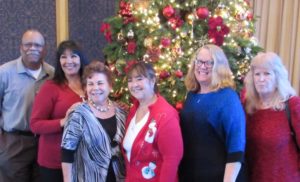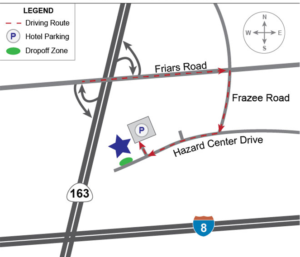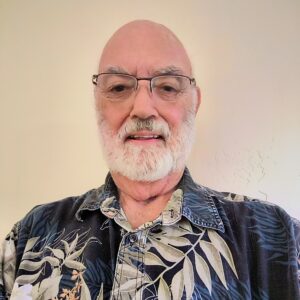November 2023
Honoring Yesterday – Protecting Tomorrow
Vol. 54, No. 11
NOVEMBER CALENDAR OF EVENTS
10—(Fri) Veterans Day observed
RESDC and SDCERA closed for holiday
14—(Tues) RESDC Board of Directors Meeting
RESDC Office, 9:30 a.m.
16—(Thurs) SDCERA Board of Retirement Meeting
9:00 a.m.
23-24—(Thurs-Fri) Thanksgiving Holidays
RESDC and SDCERA closed for holiday
View the NETWORK
as a printable PDF
Are you on social media?
Stay connected with us!![]()
![]()
QUOTE OF THE MONTH
“I have always looked at life as a voyage, mostly wonderful, sometimes frightening. In my family and friends, I have discovered treasure more valuable than gold.”
▪ Jimmy Buffet
2023 RESDC HOLIDAY LUNCHEON
DOUBLETREE HOTEL MISSION VALLEY HAZARD CENTER

When: Thursday, December 14, 2023
11:00 am – 2:00 pm
Lunch is served at 11:30 am
Where: DoubleTree Hotel (Directionsbelow)
Mission Valley Hazard Center
7450 Hazard Center Dr., San Diego, CA 92108
Menu: Roast Turkey or Vegetarian Lunch
Cost: $30 per person
Program: President’s Welcome, introduction of guests, approval of the 2024 budget, and music performed by Silverwood, a versatile music ensemble.
Registration:
Registration forms and payment must be received in the RESDC office by Thursday, December 7th. There are no refunds for cancellations after December 7th.
Reserved tables will be provided only for groups of ten who pay for the entire group with one check or one credit card. No exceptions. If wheelchair seating is required, please call our office at (619) 688-9229, or you may inform us on your registration form. Name badges and opportunity ticket packets should be picked up at the check-in table at the event. They will not be mailed.
Register Online: Go to www.resdc.net/events and click the green “Register” button. Use the email associated with your member account. Click “Add guest” to add additional registrants for $30 each. To pay for yourself and guests, click “Pay Online” and pay with credit card.
Register by Phone: Call the RESDC Office at (619688-9229 during our hours of 9 am – 2 pm Mon-Fri.
Register by Mail: Click here to print and fill out the Registration Form. Make a check payable to RESDC for $30 per person. Mail registration form, along with check to RESDC, 8825 Aero Dr., Suite 205, San Diego, CA 92123 □
RESDC HOLIDAY LUNCHEON
DIRECTIONS TO DOUBLETREE HOTEL MISSION VALLEY HAZARD CENTER

From I-8 E or W, take Hwy 163 N, exit Friar’s Road East and turn left; from Hwy 163 S, exit Friar’s Road East and turn right. Turn right on Frazee Road. Turn right on Hazard Center Drive. Turn right at Hazard Center West Driveway (2nd light) and go straight back into the “Hotel Self Park” parking. Take a ticket, which you can get validated at the luncheon check-in table for free parking. □
PRESIDENT’S MESSAGE
By Chris Heiserman
 Returning from an enjoyable two-week vacation to New England in early October, it was easy to count our blessings and remember how fortunate we are to be public sector retirees with defined benefit pension distributions arriving every month. Most of us are also receiving (or will receive) Social Security benefits and may have additional supplemental income from savings we’ve set aside.
Returning from an enjoyable two-week vacation to New England in early October, it was easy to count our blessings and remember how fortunate we are to be public sector retirees with defined benefit pension distributions arriving every month. Most of us are also receiving (or will receive) Social Security benefits and may have additional supplemental income from savings we’ve set aside.
So, on our home front life is relatively good. Still, the outside world is a scary place with a murky future, clouded by many domestic and international challenges. Of course, we can all do whatever we want with the retirement we earned. However, I believe it’s important to remain informed about current issues and do whatever we can to pass on to future generations (including our children and grandchildren) some room for optimism, not just a laundry list of seemingly insurmountable global problems. We have no magic wand as individuals to solve local, state, national or world-wide problems, but collectively Americans voice their personal opinions by participating in civic discourse and voting for good, honest leaders.
In our niche area of retirement and other concerns of the elderly, topics like threats to public pensions, inadequate retirement savings, affordable health care, etc. are front and center. New data is always being generated and sometimes new research sheds light on conditions we weren’t aware of (for example, single versus couples in retirement and their potential financial hardship). We share information we find on these issues in the NETWORK.
RESDC and other public employee state and local advocacy organizations believe all workers (public and private sector) should have retirement security. Of course, the best-case scenario would be making traditional (defined benefit) pensions available; however, realistically that ship has sailed given the decades-long trend in business to offer only defined contribution benefits [like 401(k)-style savings accounts to employees]. So, having retirement security essentially means saving enough during working years to add to other potential income sources (pensions, Social Security) to maintain a lifestyle similar to conditions before leaving the work force.
A well-documented problem is most households haven’t saved and aren’t saving nearly enough, and some aren’t saving at all. The Vanguard Group, Inc., among the biggest index and mutual fund managers in the country, does an annual report about America’s habits in saving for retirement. The 2022 report indicates there has been incremental improvement in savings behavior but not enough to make a significant difference. Among Vanguard’s large client base, participation by workers with access to 401(k) plans increased from 72% to 83% over five years. It afforded some credit for the change to the promotion of auto-enrollment in the savings plans, making it more likely workers will continue to save regularly.
Auto-enrollment is a key feature of several state-sponsored plans enacted recently (Oregon, California, and others) that require private sector employers to enroll their workers in individual savings accounts. According to Vanguard’s experience, 93% participation resulted from automatically signing up employees, even though they were permitted to opt out of the program. It said without auto-enrollment participation dropped to 70%.
The split between high and low wage owners is not surprising. Vanguard found only half of those making less than $30,000 a year were saving, while 90% of individuals making more than $100,000 were setting aside money for retirement. However, the report indicated even older labor force members who had been saving for many years still did not have the resources for a comfortable retirement. In the 2022 report, a typical 55–64-year-old worker had only $71,000 in a 401(k) account. Vanguard said that would only generate a few hundred dollars a month in retirement. Better than nothing but not adequate.
Retirement Financially Precarious for Singles
A wide disparity in financial conditions for retired single people and married couples is highlighted in a recent blog post affiliated with the Center for Retirement Research at Boston College. The post summarizes a report from the Gerontology Institute at the University of Massachusetts, Boston, which says the greatest financial hardship falls on single retirees who are minorities (Latino, Black, Asian, Native American).
The researchers use a yardstick labelled “financial insecurity” for comparison and define Americans over 65 as being financially insecure if they are either below the federal poverty level (currently $14,580), or above it but lacking enough retirement income to afford the cost of living in their area. They estimate 12 million people are in this category.
The report points out two reasons for the gap between the retirement standard of living for single people and married couples. Housing is easier to afford if two people can combine their Social Security and other sources of income and split expenses like rent, utilities, or property taxes. A related factor is that more retired women are single, and they generally had less income when they were working.
The institute’s estimates for retiree levels of financial insecurity among states produced some interesting geographic results. Asian inequality was distinctive in New York; retired Latinos were worse off in Massachusetts; the highest rate of insecurity among Black retirees was in Mississippi: and the highest insecurity rates for White couples was in two very different states, Mississippi and Vermont. □
WELCOME NEW MEMBERS
Cynthia Brown-Cooksey
Nuth Chhea, HHSA
Marivic Cruz
Vicki Devine
Susie Elliott, Superior Court
Julie Gibson, Public Defender
Lori Jones, HHSA
Tina Kydd, Superior Court
Heidi Lowe, Health Department
Kathryn McCarty
Jonathan Ogle, HHSA
Cecilia Robbins
Sharon Salazar
Leticia Speer
RECENT EVENTS
New Report Finds Alarming Retirement Outlook for Generation X.
A new report from the National Institute on Retirement Security (NIRS) finds a dismal retirement outlook for Generation X, the first generation to enter the labor market following the shift from defined benefit pension plans to 401(k)-style defined contribution accounts. When looking at median retirement savings levels for Generation X, the bottom half of earners have only a few thousand dollars saved for retirement, and the typical household has only $40,000 in retirement savings. Retirement savings for Generation X is highly concentrated among the highest earners, while Blacks and Hispanics have substantially lower savings and access to retirement plans as compared to whites.
The new report, The Forgotten Generation: Generation X Approaches Retirement, is authored by Tyler Bond, NIRS research director, Celia Ringland, NIRS research associate, and Joelle Saad-Lessler, Stevens Institute associate professor and associate dean of undergraduate studies. The report examines a wide range of metrics for assessing retirement preparedness, including sponsorship, take-up, and participation rates in employer-provided retirement plans. This research also assesses current rates of plan coverage, coverage by industry, and retirement account balances, with analyses by race, gender, and marital status where applicable.
Sourced from National Institute on Retirement Security (www.nirsonline.org)
To access the report, visit: https://www.nirsonline.org/newsroom/ □
IN MEMORIAM
Marilyn Apodaca, Information Services
Elsa Arenas, County Counsel
John Armstrong
Willa Athey
Felizardo Barcarse
Armando Belenzo, Agric, Wghts & Meas
Susan Cargill, HHSA
Irene Carr
Renee Collier, HHSA
Amor De La Rosa, Probation
Arlene Dewhurst, Superior Court
David Dosch, HHSA
Roger Doughman, Public Works
Richard Eustace, Facilities Mgmt
Allison Fomon, District Attorney
Daniel Fox
Gilbert Garcia, Parks & Recreation
Allen Goldsmith, Inactive Waste Site Mgmt
Geraldine Hayes
Viola Johnson, Assessor/Recorder/Cty Clk
Marvin Jones
Virginia Kazmaier
Anna Lindquist, HHSA
Mary Long, Sheriff
Ruth Lopez, HHSA
Alfred Mackrille, Sheriff
Patsy McKinney, Revenue & Recovery
Jerry McLees
Arlene McMath, HHSA
Allen Narcisse, Sheriff
Carole Norman, HHSA
Lenna Nunn
J. O Connell Jr.
Herberth Orellana, HHSA
Alaisea Pauu, Sheriff
Lynette Pelley, District Attorney
Sally Peterson
Cecil Ralph
Sari Reznick, HHSA
Yannira Rodriguez, HHSA
Bertha Romeo, HHSA
Marilyn Ryan, Superior Court
Mary Stewart
Phu Ton, HHSA
Elice Tucker, Superior Court
Ricardo Valadez, HHSA
Joseph Valencia, Planning & Development
Lydia Werner, Sheriff
Patricia Wheeler, HHSA
Joyce Whiting
Terrence Whitworth, HHSA
Barbara Zimmerman
*Active Employee
MEMBER PRIVACY
Any retiree or surviving spouse who does not want his/her death notice published in the “In Memoriam” column may notify the RESDC office and your privacy will be maintained.
The Surviving Spouse of a RESDC member is eligible for RESDC membership. For enrollment assistance, please call (619) 688-9229. □
SDCERA NEWS
ONLINE TAX WITHHOLDING CALCULATOR NOW AVAILABLE
You can now estimate how much your pension will be taxed using the new SDCERA online tax withholding calculator.
Enter your gross pension amount, allowances, and deductions to see an estimate of the federal and California state taxes that will be withheld each month.
Try it out now at www.sdcera.org. Once you’ve used the calculator, you will need to fill out the federal tax withholding or state tax withholding form. You can fill out, sign and submit the forms online through the SDCERA Member Portal at memberportal.sdcera.org. □
THINGS YOU SHOULD (OR COULD) KEEP ON YOUR SMARTPHONE
By Chuck Brown, Director
 A recent Reader’s Digest article on carrying images of important documents on your smartphone. As a life-long tech nerd with experience in IT security, I was skeptical: What if I lose my phone? In general, that would be bad enough, but with the items discussed in the article it could be catastrophic. It got my attention and a couple of things made me think it was an okay idea. First, I have a PIN to unlock my phone (that’s gate #1). That’s a carry-over from my old phone. I could have “upgraded” to fingerprint or facial recognition. Second, newer smartphones have a “Safe” or “Secure” folder function that allows us to use a PIN, fingerprint, etc. (that’s gatekeeper #2).
A recent Reader’s Digest article on carrying images of important documents on your smartphone. As a life-long tech nerd with experience in IT security, I was skeptical: What if I lose my phone? In general, that would be bad enough, but with the items discussed in the article it could be catastrophic. It got my attention and a couple of things made me think it was an okay idea. First, I have a PIN to unlock my phone (that’s gate #1). That’s a carry-over from my old phone. I could have “upgraded” to fingerprint or facial recognition. Second, newer smartphones have a “Safe” or “Secure” folder function that allows us to use a PIN, fingerprint, etc. (that’s gatekeeper #2).
Depending on your smartphone – Android or iPhone – you can set up a folder for these secure documents. Reader’s Digest recommends taking photos of the originals. If you didn’t, as I do, already have a secure log of most of the items they recommend, then photos could be a good choice.
The article recommends the photos you ought to have on your smartphone for reference, for emergencies, and for peace of mind. Place them in a dedicated photo album on your phone so you don’t have to scan through hundreds of family snaps to find them. Make sure that album/folder is then set up to be secure/safe. Here are some, not all, of the tips:
- Rental car photo (so you can find it in the parking lot
- COVID Vaccination Record (It was handy during the shutdown)
- Driver License (In some states, a digital ID is valid)
- Vehicle license plate and VIN (To quickly report loss, stolen, etc.)
- Passport (In case you lose it while traveling)
- Medicare/Medicaid Card (Proof of insurance)
- Medical and Dental insurance cards (Proof of insurance)
- Auto insurance proof card (Your insurer may provide online images)
- Bank Account and Routing Numbers (To quickly report loss or ID theft)
- Credit/Debit Card Numbers and Customer Service numbers. (To quickly report loss or ID theft)
There are additional items to be considered. The full article can be found at https://www.rd.com/list/photos-you-should-carry/ □
PURCHASE SEE’S CANDIES GIFT CARDS ONLINE
You can now purchase See’s Candies gift cards in our new Online Store using your RESDC discount!
RESDC members are offered $25 gift cards for $22, a savings of $3. Gift cards are redeemable at any See’s Candies location or online.
To purchase gift cards online, go to: resdc.wildapricot.org/online-store
Note: You need a RESDC member self-service login in order to access the online store. If you need one, please email resdc@resdc.net. □
PENSION FACTS
AT A GLANCE
15.2%
Share of California’s population that was 65 years and over in 2020. New York’s figure was 16.9%; Texas’ was 13.5%.
(U.S. Census Bureau)
BITS & PIECES
Award-winning author and RESDC member Marty Martins’ new book, “The Maui Murders: Death & Romance on the Valley Isle,” combines his law enforcement experience with his knowledge of Hawai’i in a thriller about a serial killer in paradise.
Susan Melendez did a Transatlantic cruise this year. From Miami to Barcelona. Their first port after seven days was Punta del Gada in the Azores. They were celebrating Festa do Senhor Santo Cristo Milagres on the day they arrived. Their main street was decorated with dyed bark pieces arranged into beautiful pictures. They traveled to two more ports in Portugal and three in Spain. After the cruise, they flew to Frankfurt, Germany to do the Romantic Road tour. They shared this tour with people from Russia, Greece, Japan and Spain. What a great group to travel with! “And of course” Susan remarks, “I had to climb up and walk the city wall in Rothenburg.” □
THE NETWORK is the official monthly newsletter of the Retired Employees of San Diego County, Inc. (RESDC), a private non-profit organization.
The information printed in THE NETWORK is believed to be from reliable sources. However, no responsibility is assumed by THE NETWORK for inaccuracies contained herein.
Business and Inquiries: Business matters and address changes may be recorded on our voicemail at any time, call (866) 688-9229. Please spell your name so the correct member record can be located.
Retired Employees of San Diego County, Inc.
8825 Aero Drive, Suite 205 | San Diego, CA 92123
Office Hours: 9 a.m. to 2 p.m. Monday through Friday
TELEPHONE: (866) 688-9229 Toll Free
FAX: (619) 688-0766
E-MAIL: resdc@resdc.net

